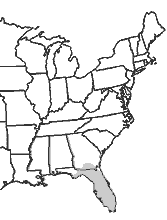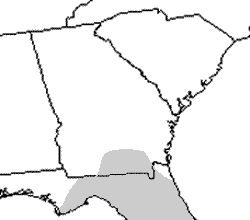Striped Crayfish Snake (Regina alleni)



Photos by J.D. Willson unless otherwise noted
Description: Striped crayfish snakes are mid-sized, highly aquatic snakes, ranging in size from 14 – 20 in (35.5 – 50.8 cm). They are somewhat heavy-bodied with short heads and large eyes. Coloration is shiny brownish to green with three inconspicuous stripes running down the body. The underside is yellow to orange with a row of dark spots that runs down the center of the belly. Adult females are larger than adult males. This species is similar to the glossy crayfish snake (R. rigida) but has only one row of spots on the venter (R. rigida has two). In our region this species is restricted to extreme southern Georgia and thus can often be ruled out when identifying snakes from SC and GA.
Range and Habitat: The striped crayfish snake is most common in peninsular Florida and has only recently been found in a few locations in extreme southern Georgia . They are highly aquatic and inhabit a variety of aquatic habitats including cypress stands, saw grass prairies, swamps, sphagnum bogs, and roadside ditches. This species has adapted well to the beds of introduced water hyacinth that now choke many waterways in the Southeast and can be one of the most abundant vertebrates in these habitats.
Habits: The striped crayfish snake is extremely secretive and aquatic and is thus seldom seen. Occasionally individuals are found crossing roads on rainy nights and they may be collected by setting minnow traps in shallow water or ripping through mats of aquatic vegetation. Adult striped crayfish snakes feed primarily on hard-shelled crayfish but juvenile also eat odonate (dragonfly) naiads or seasonally abundant shrimp in some areas. They use their coils not to constrict their prey but to hold them while they consume the crayfish alive. Like other natricine watersnakes, this species gives birth to 4 to 12 live young in the summer or early fall.
Interesting Facts: Much of what is known about the ecology of R. alleni comes from the work of Godley (1980). Godley found that in suitable habitat in southern Florida, R. alleni can be extremely abundant, reaching densities of 1,289 snakes/ha. In these habitats, juvenile R. alleni were capable of consuming a large proportion of odonate naiads present in the habitat each year. To date this study remains one of the most concrete examples of the importance of snakes to ecosystem functioning.
Conservation Status: Although not legally protected in most of its range, this snake is of conservation concern. It has a Georgia state Heritage rank of S2 and is protected throughout the state of Georgia.
Pertinent References:
Godley, J. S. 1980. Foraging ecology of the striped swamp snake, Regina alleni, in Southern Florida . Ecological Monographs 50:411-436.
Account Author: Jonathan Sloan, University of Georgia – revised by J.D. Willson
